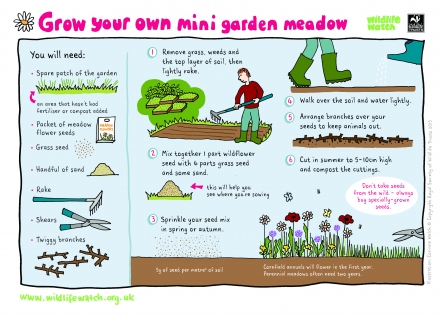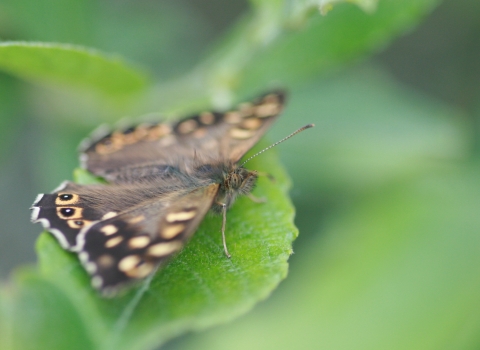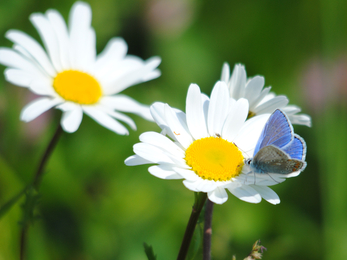Butterflies need our help
Butterflies are far less common now than they were seventy years ago and you don’t have to look hard to see why. Since the 1940's, we have lost 97% of flower rich meadows together with much heathland, ancient woodland and peat bogs.
Even common butterflies have lost out as hedges and field edges rich in wild flowers and grasses have gone under the plough. So what can we do to help?
What do butterflies like?
Butterflies visit gardens to drink nectar from flowers. Butterflies are very active and nectar provides the fuel they need to keep airborne.
Many good nectar plants are hardy perennials like you would find in a cottage border or meadow and easy to grow. Butterflies also like basking on hot stones or gravel to warm up their wings.
Flowers for butterflies
Avoid highly-bred cultivars with big and blowsy, double flowers most of which contain little or no pollen or nectar.
Single flowered varieties are better.
Plant a good selection of different nectar plants in sunny spots.
Have a look at our plant list for pollinators to get ideas for your garden.
When do they need our help?
Have flowers available from early spring to late autumn.
Early flowers are great for butterflies coming out of hibernation, while in late summer and autumn they need to build up their reserves in preparation for winter.
Provide winter homes such as hedges, ivy or other evergreen climbers on fences or walls for butterflies to hibernate in.
Hibernation
White, browns and blues over-winter as chrysalis.
Painted lady and red admiral usually migrate to Europe.
Brimstone, peacock and small tortoiseshell hibernate in shrubs and buildings as adults.
Plants for all pollinators through the seasons
Choose a mixture of seasonal flowering plants, shrubs and trees to ensure a year round food source in your garden. Look on our meadow pages for ideas on wildflowers.
Winter
Winter heathers, mahonia, crocus, snow drops, witch hazel, Viburnum tinus, sweet box
Spring
Aubretia, alyssum, Bowles’ mauve perennial wallflower, blackthorn, bluebell, blackberry, bugle, clover, comfrey, native cowslip, crocus, cuckoo flower, dandelion, dicentra, field scabious, forget-me-not, flowering currant, heathers, honesty, lungwort, ox-eye daisy, native primrose, goat and grey willow, sweet rocket, violets, wallflower
Summer
Allium, aster (Novi-angliae cultivars and Aster amellus and its cultivars; these two species are not invasive), aquilegia, borage, bugloss, california lilac, campanula, catmint, chives, corn flower, globe thistle, hardy geraniums (cranesbills), escallonia, evening primrose, foxglove, heathers, hebe, honeysuckle, Jacob’s ladder, lamb’s ear, lavender, lobelia, lupins, marjoram, marigolds, mint, nasturtium, Phacelia tanacetifolia, phlox, poppy, rock-rose, rosemary, sage, scabious, salvia species, sea holly, sweet william, sunflower, thyme, verbena, viburnum, viper’s bugloss, yarrow
Autumn
catmint, cone flower, cosmos, hemp agrimony, fleabane, heathers, ivy, knapweed, lucerne, michaelmas daisy, Sedum spectabile ‘Ice Plant’, St John’s wort, teasel, thistles
Larval food plants
It’s important to provide food for the caterpillars as well as the adult butterflies
Here are some suggestions:
Bird’s foot trefoil – common blue,
Buckthorn or alder buckthorn - brimstone,
Common or sheep sorrel - small copper,
Cuckoo flower, garlic mustard, honesty and Sweet rocket - orange tip, green-veined white,
Holly and ivy – holly blue,
Hops – comma,
Nasturtium – large and small white,
Native grasses; bents, cock’s foot, meadow grass, fescues, Yorkshire fog, Timothy grass, false brome- Meadow brown, gatekeeper, wall, ringlet, small skipper, speckled wood
Stinging nettle - small tortoiseshell, peacock, comma, red admiral,
Thistles and nettles- painted lady
Is my lawn important for butterflies?
- Many butterflies such as meadow brown and gatekeepers lay their eggs on grass so leave an area to grow tall over summer.
- Don’t cut these areas lower than 15cm over winter as the caterpillar will hibernate in grassy clumps.
- Leave some areas uncut if you can.
Small garden?
Don’t worry - you can grow some of these plants in a container pot or a window box – butterflies won’t mind! Just make sure there is a little sunshine so butterflies can bask in the warmth.
Grow your own mini meadow

Grow your own mini meadow garden Activity Sheet





